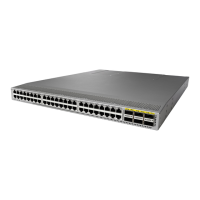Send comments to nexus3k-docfeedback@cisco.com
-SM-301
Cisco Nexus 3000 Series NX-OS System Management Command Reference
OL-29557-04
Chapter System Management Commands
snmp-server context
snmp-server context
To configure the Simple Network Management Protocol (SNMP) context to logical network entity
mapping, use the snmp-server context command. To remove the context, use the no form of this
command.
snmp-server context context-name [instance instance-name] [vrf {vrf-name | default |
management}] [topology topology-name]
no snmp-server context context-name [instance instance-name] [vrf {vrf-name | default |
management}] [topology topology-name]
Syntax Description
Command Default None
Command Modes Global configuration mode
Command History
Usage Guidelines Use the snmp-server context command to map between SNMP contexts and logical network entities,
such as protocol instances or VRFs.
Examples This example shows how to map the public1 context to the default VRF:
switch# configure terminal
switch(config)# snmp-server context public1 vrf default
switch(config)#
context-name SNMP context. The name can be any alphanumeric string up to 32
characters.
instance instance-name (Optional) Specifies a protocol instance. The name can be any alphanumeric
string up to 32 characters.
vrf vrf-name (Optional) Specifies the virtual routing and forwarding (VRF) instance. The
name is case sensitive, and can be a maximum of 32 alphanumeric
characters.
default Specifies the default VRF.
management Specifies the management VRF.
topology
topology-name
(Optional) Specifies the topology. The name can be any alphanumeric string
up to 32 characters.
Release Modification
5.0(3)U1(1) This command was introduced.

